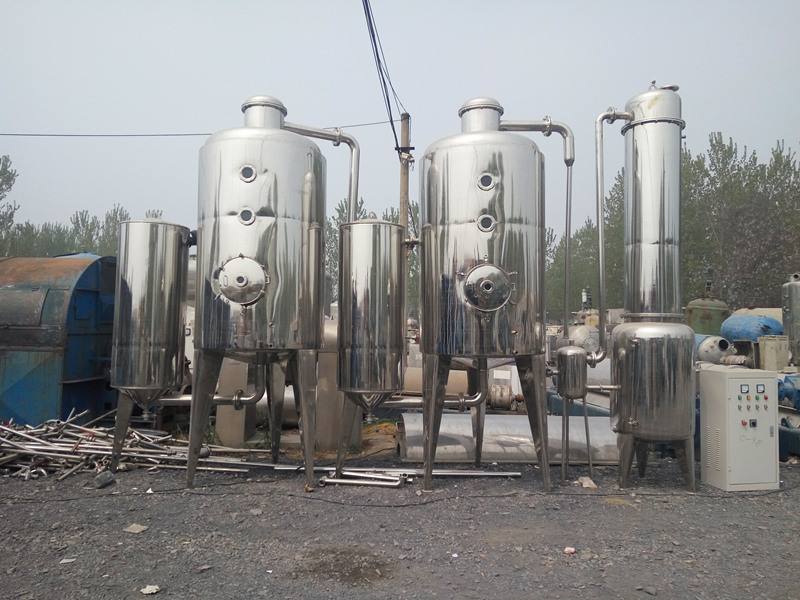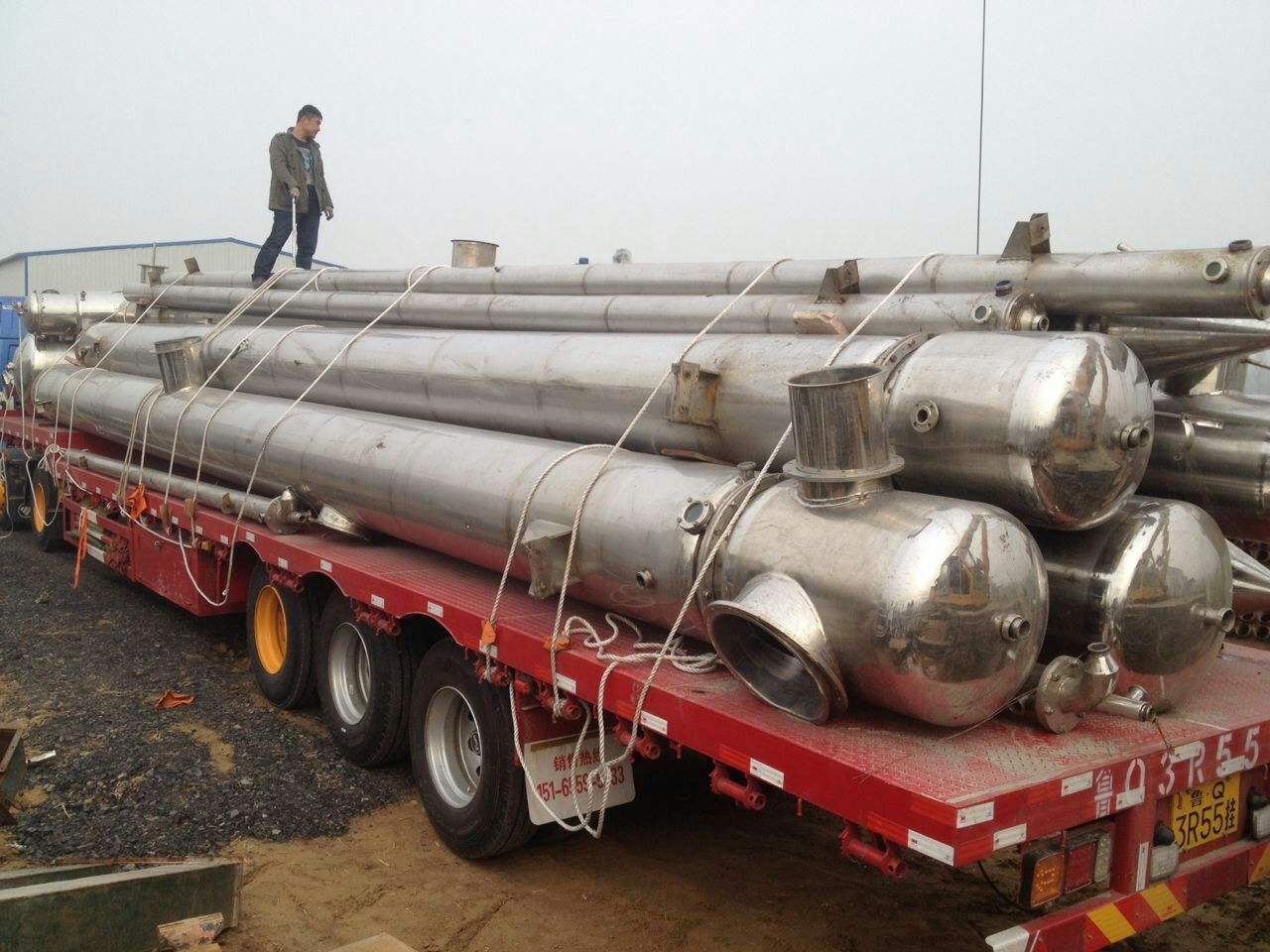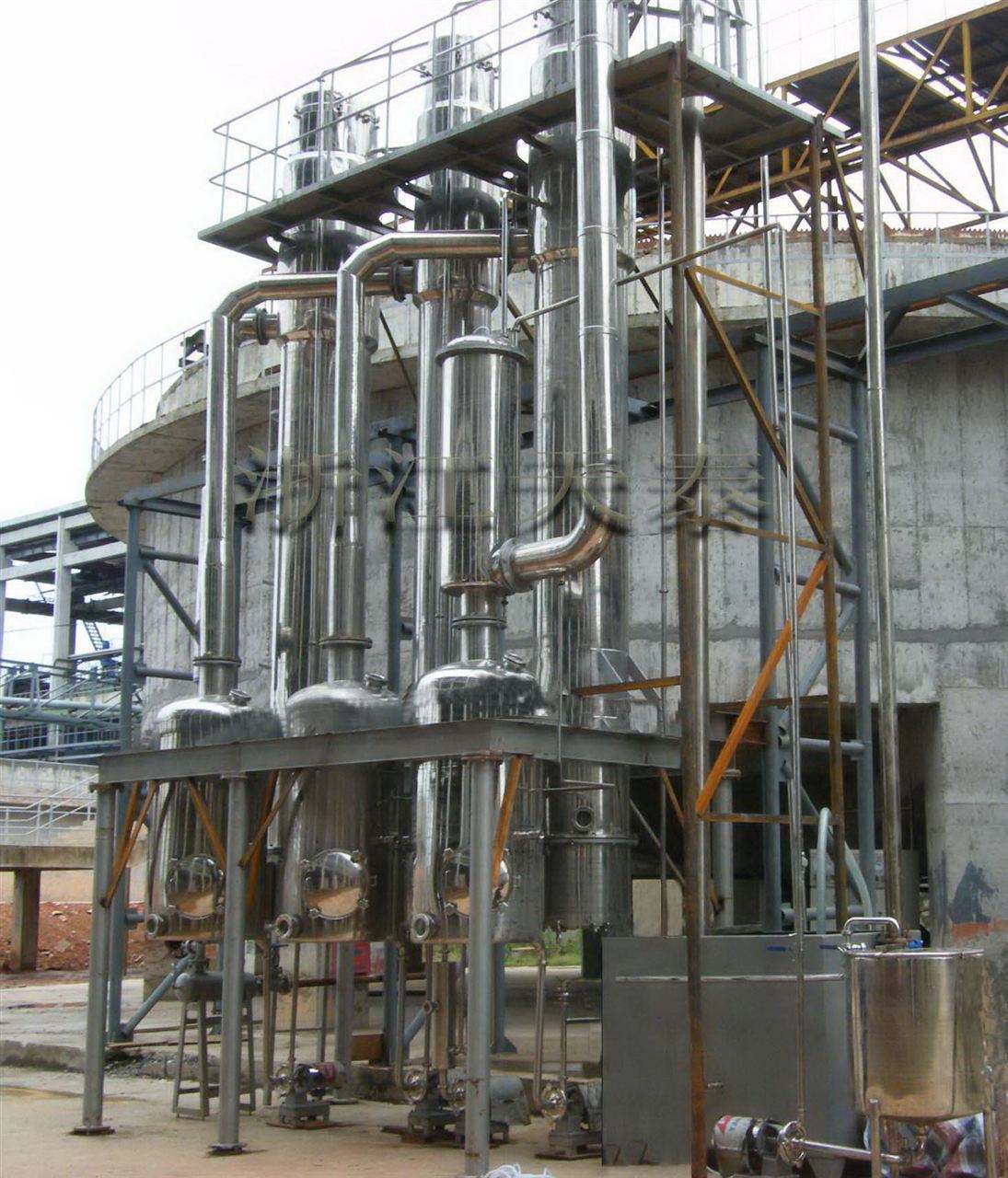Falling film evaporation is to add the liquid to the upper tube of the heating chamber of the falling film evaporator. Through the liquid distribution and film forming device, it is evenly distributed into the heat exchange tubes. Under the action of gravity and vacuum induction and air flow, it becomes a uniform film. Flow from top to bottom. During the flow, it is heated and vaporized by the shell-side heating medium, and the generated steam and the liquid phase enter the separation chamber of the evaporator. The vapor-liquid is sufficiently separated, and the steam enters the condenser for condensation (single-effect operation) or enters the next-effect evaporator. The medium is heated to achieve multi-effect operation, and the liquid phase is discharged from the separation chamber.
Process flow:
The falling film evaporator process has four forms: downstream (cocurrent), countercurrent, mixed flow (crossflow) and advection:
Downstream:
The solution and the steam flow are the same, and all flow from one effect to the last. The raw material liquid is pumped into one effect, and the pressure difference between the various effects is automatically flowed into the next effect, and the finished liquid is pumped out from the last effect (generally operated under a negative pressure). Since the pressure of the latter effect is low, the boiling point of the solution is also low, and the solution will flash part of the water after the first effect, and the secondary steam generated is also more, because the post-effect concentration is higher than the pre-effect and the operating temperature is low. The heat transfer coefficient of the *effect is often much higher than the final effect. The downstream process is generally suitable for processing materials that are heat sensitive at high concentrations.
countercurrent:
The raw materials are sent to the pre-effect by the pump from the final effect, and the finished liquid is discharged by one effect, and the feed liquid and the steam flow in the opposite direction. Generally, it is suitable to treat a solution whose viscosity changes greatly with temperature and concentration, and it is difficult to handle heat sensitive materials.
Mixed flow:
It is a combination of the forward flow process and the advantage of the forward flow to avoid its shortcomings, but the operation is complicated and requires a high degree of self-control.
advection:
Each effect feeds out the completion liquid, and each effect has crystal precipitation, which can be separated and crystallized in time, and is generally used for evaporation of a saturated solution.
Falling film evaporator features:
(1) aspect ratio L/d=100~250; (2) heat transfer coefficient k=1000~3000 kcal/(m2*degree Celsius*);
(3) It can handle materials with large concentration and poor fluidity;
(4) The heat transfer temperature difference is small, and there is no liquid column static pressure. 


DVR 5MP, also called the Digital Video Recorder DVR 5MP/ Digital Video Recorder 5MP/ DVR CCTV 5MP/ DVR 5MP 4CH/ 5MP HD DVR/ 5MP DVR Security System, means that this Digital Video Recorder has 5 million pixels.
So what does 5MP pixels stands for?
The letter "M" means million, and the letter "P" means pix, so 5MP means 5 megapixels. MP refers to MegaPixel.Some cameras only display 1M, 3M, 5M, etc.,. more specifically speaking, 5MP means that the camera is set at 5 million pixels to take photos. By analogy, 3MP is 3 million pixels, and 16MP is 16 million pixels.
So does the pixel mean?
The pixel refers to the smallest unit in an image represented by a sequence of numbers.
The pixel is composed of the small aquares of an image. These small squares have a clear position and assigned color value in this image, and the color and position of the small squares can determine what this image looks like. We can regard the pixel as the indivisible unit or element in the entire image. The pixel is indivisible, which means it can't be cut into smaller units or elements because it exists as a single color grid. Each bitmap image contains a certain amount of pixels, which can determine the size of the image on the screen.
The pixel for the camera actually means the maximum pixel. Pixel is the unit of resolution. This pixel value only refers to the maximum effective resolution the camera supports.
For example, the resolution of 0.3MP is 640×480, 0.5MP is 800×600, 0.8MP is 1024×768 5" (3.5×5 inches), 1.3MP is 1280×960 6" (4×6 inches), 2MP is 1600×1200 8" (6×8 inches) 5" (3.5×5 inches), 3.1MP is 2048×1536 10" (8×10 inches) 7" (5×7 inches), 4.3MP is 2400×1800 12" (10×12 inches) 8" (6×8 inches), 5MP is 2560×1920 12" (10×12 inches) 8" (6×8 inches), 6MP is 3000×2000 14" (11×14 inches) 10" (8×10 inches), 8MP is 3264×2488 16"(12×16 inches) 10" (8×10 inches), 11MP is 4080×2720 20" (16×20 inches) 12" (10×12 inches), 14MP is 4536×3024 24" (18×24 inches) 14" (11×14 inches), and all these are the approximate dimensions.
When we measure the picture size in pixels, we need to specify its fixed resolution first, then we can convert the picture size to the actual size. For example, the commonly used resolution of the pictures in the web page making is 72, that is, 72 pixels per inch, and 1 inch is equal to 2.54 cm. Then, through conversion, we can know that each cm is equal to 28 pixels; another example is a picture with the size of 15x15 cm, which is equal to 420*420 pixels.
DPI means ** dots per inch
LPI means ** lines per inch
PPI means **pixels per inch

In conclusion, we should pick up the most suitable pixels when we choose the security cameras and DVRs.
DVR 5MP, Digital Video Recorder 5MP, DVR CCTV 5MP, DVR 5MP 4CH, 5MP HD DVR, 5MP DVR Security System
SHENZHEN SANAN TECHNOLOGY CO.,LTD , https://www.sanan-cctv.com